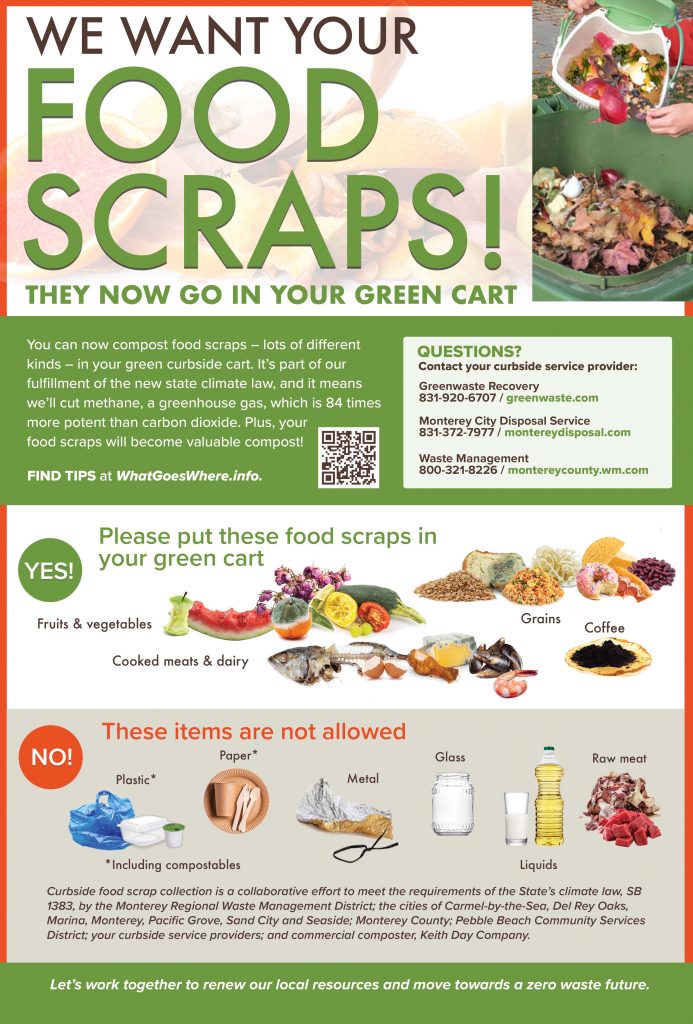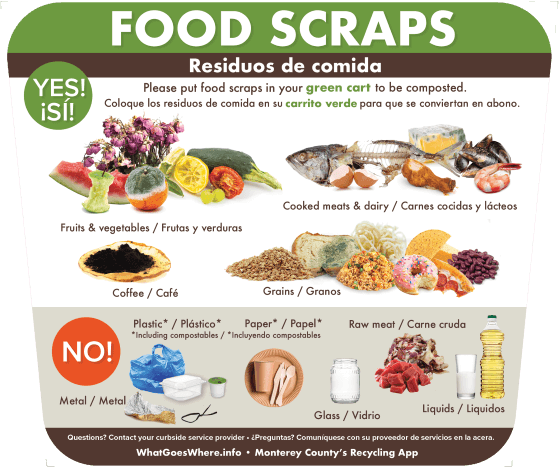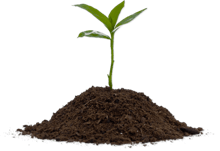DON’T BAG THEM -
Collect them…
Chill them…
Curb Them...
FAQs
Curbside Food Scrap Collection
- When can I begin putting food scraps into my green cart?
Beginning January 1, 2022 residents can add accepted food scraps to their green curbside cart. Food scrap collection is part of the implementation of California’s SB 1383 legislation addressing climate pollutants and wasted food. We look forward to supporting everyone’s participation and success. Please check out the acceptance list for what you can put into the cart with your yard trimmings – including trimmings from your produce, the inedible parts of food e.g. shells and bones, plate scrapings, spoiled food; all but raw meat and liquids including oils. You’re encouraged to reach out to your curbside service provider if you have additional concerns or questions. We want to get this right; and we know that “slow and steady wins the race”. - Why are we having to compost our food scraps now? Will I be fined if I don’t?
Food scrap composting is one way the state is addressing climate pollutants and keeping wasted food out of landfills where they produce methane, a potent greenhouse gas. Residents are strongly encouraged to participate. As part of the law, the State will require cities and counties to notice and fine those who place food scraps in their trash or recycling starting in 2024.
- Will curbside collection cost more?
Residents will use their existing green cart, so they won’t need to pay for additional service. If you don’t have a green cart, please call your curbside service provider to request one. - What if I live in a apartment or condo? Can I participate too?
Residents in multifamily residences are able to participate in food scrap collection too. Ask your property manager about the new collection – where the cart will be and when they will have it on site - What food scraps are accepted in the cart?
All unpackaged food scraps are accepted with the exception of raw meat, oil and liquids. This includes the inedible parts of food, food scraps, spoiled food and trimmings from food preparation. Please remove all packaging, including paper, plastic, glass, and metal and recycle what you can. Reuse the twist ties and the rubber bands, but please don’t put them in the green cart. They can contaminate the end product, compost.
- Are there free kitchen collection pails available to residents?
Yes, please pick up your kitchen pail from your city of residence. Locations are listed below (Carmel and Pacific Grove are currently out of supplies). Limit one per household.
You may also use or repurpose any container to collect kitchen scraps.
Del Rey Oaks: City Hall, 650 Canyon Del Rey Blvd
Marina: Community Development/Public Works office, 209 Cypress Avenue
City of Monterey: Monterey City Disposal office, 10 Ryan Ranch Road
Pebble Beach: Pebble Beach Community Services District, 3101 Forest Lake Drive
Monterey County: Monterey County Courthouse Basement, 1200 Aquajito Road #107
Sand City: City Hall, 1 Pendergrass Way
Seaside: City Hall, 440 Harcourt Avenue, Oldemeyer Center, 986 Hilby Avenue and Seaside Creates, 656 Broadway Avenue
- How do I avoid the “ick” and “eww”?
Choose a small container to collect your food scraps in. It can be a small bowl, a repurposed container such as an empty milk jug, or a kitchen pail. Glass and metal are easy to clean and don’t absorb odors. A cover helps too. Empty your kitchen container frequently to the curbside cart. Every few days is a good rule of thumb. Can’t or don’t want to empty it that frequently? Store it in a covered container or bag in the freezer or refrigerator to prevent break down and odors. - How do I prevent the “ick” in the cart?
Layer your food scraps with your yard trimmings. It’s helpful to keep a bucket or pile of dry yard material (e.g. leaves, pine needles, straw, wood shavings, etc.) at the ready to cover your food scraps. Placing a layer of yard trimmings at the bottom of your cart will help keep your cart clean longer. - Can I bag my food scraps and put them into my cart? Plastic, paper and compostable bags are not accepted in the program, as they become a contaminate in the compost, create operational concerns and do not break down in our composting process. Please discard unbagged food scraps directly in your green cart along with your yard trimmings.
- What happens if my cart gets moldy, smelly, or is attracting pests?
Try preventative measures first, such as freezing your food scraps and putting them into your cart the night before pick-up. Also try layering your food scraps between yard trimmings. Keeping food scraps covered with plant material and the lid closed, will prevent insects, birds, and other critters. Keep in mind that we are discarding the same materials, they just need to go into a different container. Contact your curbside service provider if you need more assistance. - I want to home compost, can I do that instead of the curbside service? You sure can! Home composting is a great option. You can find “how-to” guides and information on home compost bins at www.mrwmd.org/composting. And for those hard-to-decompose items (bones, shells, etc.), consider adding them to your green curbside cart.
- Where is the compost made and what happens to it afterwards?
Your food scraps are delivered to the Monterey Regional Waste Management District, where Keith Day Company (KDC) processes them and makes the compost. The finished compost is then used in diverse landscape, horticulture, and agricultural applications. - Can I get compost for my garden?
Each city and county will have a plan to procure finished compost for use in municipal projects and to make some available for residential use. Please check with your city or county office for availability. - Why is reducing wasted food important?
Wasted food has social, environmental and economic impacts, the following being identified by the Environmental Protection Agency (EPA).
Wasted food is a social problem:
In 2018, 11.1 percent of U.S. households were food insecure at some time during the year; that is 37.2 million Americans, of which 11.2 million are children, living in food insecure households.
Wasted food is an environmental problem:
Food is the largest stream of materials in American trash. Once wasted food reaches landfills, it produces methane, a powerful greenhouse gas.
Wasted food is an economic issue:
It is estimated that at the retail and consumer levels in the United States, food loss and waste totals $161 billion dollars, annually. - Why are we not able to put certified compostable plastic food service, like cups, utensils, and to-go containers in the green cart with our food scraps? Aren’t they compostable?
As many of us phase out single-use plastics from our lives and are looking for alternatives, compostable service ware seems like a good option. Some of their attributes make them better than other single-use service ware, but there are many reasons why they are not being accepted in the residential food scrap collection. First, it can be almost impossible to identify compostable items and discern them from non‐compostable products in a municipal compost operation. This can lead to confusion at the curb, and increases the labor and cost involved in prescreening the bagged material when it arrives to the compost facility. So, unfortunately, both non-compostable and compostable plastics cause operational and environmental concerns. Secondly, compostable plastic service ware and bags don’t always break down completely, or at the same rate as yard trimmings, even in a commercial composting system; therefore, they are screened out and landfilled, adding to the costs, and impacting the quality and usability of the final product. Lastly, “compostable” fiber‐ food service products may contain chemicals, including fluorine compounds like PFAS, used in food packaging, as a grease barrier. PFAS have been referred to as “forever chemicals”, as they breakdown slowly and have been found to persist in the environment – soil and water, and bioaccumulate (build up) in the systems of humans and animals. For these reasons, compostable food service ware is not being accepted in the green cart, assurance of best practices is needed from collection to use to produce a safe, quality product. - Why shouldn’t I use my garbage disposal for my food scraps? It’s convenient and they don’t go to the landfill.
This is a good question. It may be more convenient, but what we often don’t see or realize is the process of moving and treating our wastewater is resource extensive, including the cost to us and our municipalities. A large amount of energy, water and chemicals are used to get our food scraps from our kitchen disposals, over the miles between your home and the wastewater treatment plant and then processed through the treatment system, including physical, chemical and biological treatment, separating out the solids, known as biosolids. Biosolids, are transported to a permitted facility for composting, land application or to a landfill. So, when we choose the cart over the disposal, we conserve valuable resources, contribute towards a beneficial new resource–compost, and we also reduce carbon emissions by saving energy otherwise generated to move and treat water.
- Can I put my coffee filter in with my coffee grounds? And tea bags too?
Coffee filters are accepted but can be problematic. The sheer volume can create litter and operational challenges, as well as many paper filters are bleached with chlorine which could leach into the compost and soil. Unbleached ones are better for us and the planet. Tea bags are not accepted. Why not? Most often they are made from bleached paper, plastic, or nylon, most include staples, strings and paper tags and can be sealed with glue and other chemicals, so can present both operational and product quality concerns. Consider a reusable metal, ceramic or organic cloth filter or no filter at all by using a French press or a good old-fashioned tea pot. - Who do I contact if I have more questions?
For service and collection questions you should contact your curbside service provider. If you have questions about how mandated programs are being implemented in your community, you should contact city or county staff.
Learn more about why sustainable management of food is important.
Resources
Return Nutrients to the Soil –
If you can’t prevent, reduce or donate wasted food, you can compost.
By sending food scraps to a composting facility instead of to a landfill or composting at home, you’re helping make healthy soils.
Adding compost to gardens, highway construction sites, and poor soils makes great things happen.
Properly composted organics (wasted food and yard waste) improve soil health and structure, improve water retention, support more native plants, and reduce the need for fertilizers and pesticides





